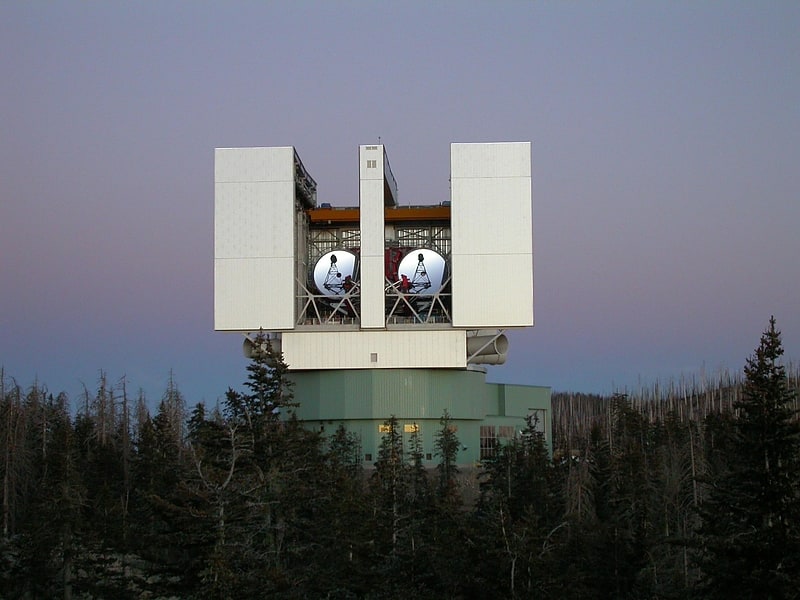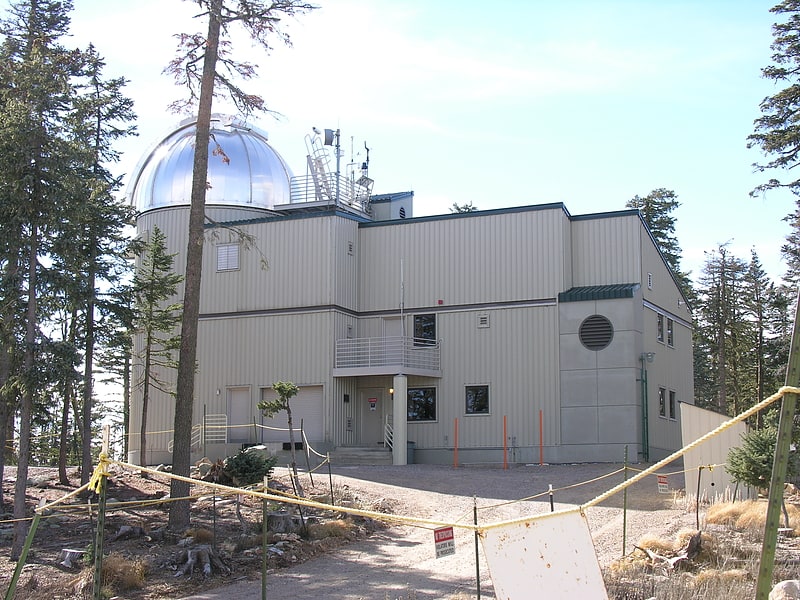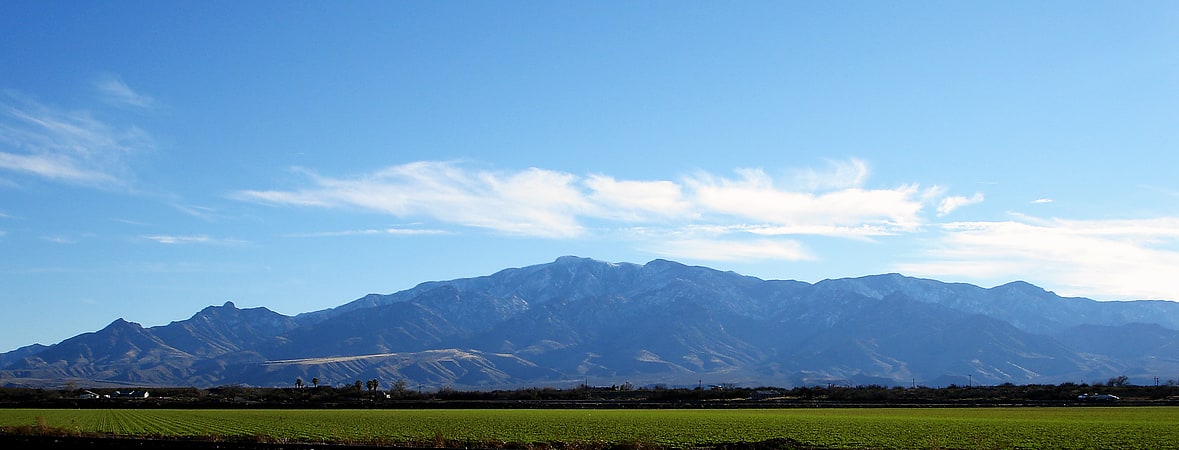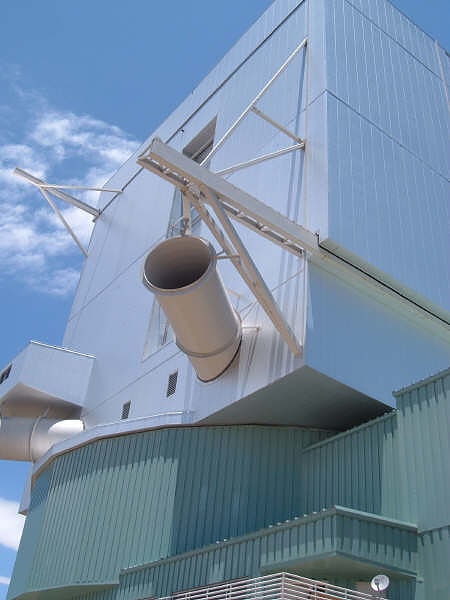Discover 6 hidden attractions, cool sights, and unusual things to do in Coronado National Forest (United States). Don't miss out on these must-see attractions: Large Binocular Telescope, Vatican Advanced Technology Telescope, and Heinrich Hertz Submillimeter Telescope. Also, be sure to include Pinaleño Mountains in your itinerary.
Below, you can find the list of the most amazing places you should visit in Coronado National Forest (Arizona).
Table of Contents
Large Binocular Telescope

Observatory in Graham County, Arizona. The Large Binocular Telescope is an optical telescope for astronomy located on 10,700-foot Mount Graham, in the Pinaleno Mountains of southeastern Arizona, United States. It is a part of the Mount Graham International Observatory.
When using both 8.4 m (330 inch) wide mirrors, with centres 14.4 m apart, the LBT has the same light-gathering ability as a 11.8 m (464 inch) wide single circular telescope and the resolution of a 22.8 m (897 inch) wide one.
The LBT mirrors individually are the joint second-largest optical telescope in continental North America, next to the Hobby–Eberly Telescope in West Texas. It has the largest monolithic, or non-segmented, mirror in an optical telescope.
Strehl ratios of 60–90% in the infrared H band and 95% in the infrared M band have been achieved by the LBT.[1]
Vatican Advanced Technology Telescope

Observatory in Graham County, Arizona. The 1.8 meter Alice P. Lennon Telescope and its Thomas J. Bannan Astrophysics Facility, known together as the Vatican Advanced Technology Telescope, is a Gregorian telescope observing in the optical and infrared situated on Mount Graham in southeast Arizona, United States. It achieved its first light in 1993.
VATT is part of the Mount Graham International Observatory and is operated by the Vatican Observatory, one of the oldest astronomical research institutions in the world, in partnership with The University of Arizona.[2]
Heinrich Hertz Submillimeter Telescope

Observatory in Graham County, Arizona. The Submillimeter Telescope, formerly known as the Heinrich Hertz Submillimeter Telescope, is a submillimeter wavelength radio telescope located on Mount Graham, Arizona, US. It is a 10-meter-wide parabolic dish inside a building to protect it from bad weather. The building front doors and roof are opened when the telescope is in use. The telescope's construction was finished in 1993. Along with the 12 Meter Telescope on Kitt Peak, this telescope is maintained by the Arizona Radio Observatory, a division of Steward Observatory at the University of Arizona.
The dryness of the air around and above Mount Graham is important for extremely high frequency (EHF) radio and far-infrared observations – a region of the spectrum where the electromagnetic waves are strongly attenuated by any water vapor or clouds in the air.
This telescope is used nine to ten months of the year, and it is stowed only when there is too much water vapor in the atmosphere, primarily during the summertime. This telescope is one of the telescopes that make up Mount Graham International Observatory.[3]
Pinaleño Mountains

Mountain range in Arizona. The Pinaleño Mountains, are a remote mountain range in southeastern Arizona, near Safford, Arizona. The mountains have over 7,000 feet of vertical relief, more than any other range in the state. The mountains are surrounded by the Sonoran-Chihuahuan Desert. Subalpine forests cover the higher elevations. According to The Nature Conservancy, they traverse five ecological communities and contain "the highest diversity of habitats of any mountain range in North America." The highest point is Mount Graham at 10,720 feet. Locals often refer to the whole mountain range as "Mount Graham", in which case the peak is referred to as "High Peak". The mountains cover 300 square miles and are part of the Coronado National Forest, Safford ranger district.
The Pinaleño/Pinal Band (Spanish term: "Pinery People", Western Apache: Tiis Ebah Nnee—"Cottonwoods Gray in the Rocks People") of the San Carlos Apache (Tsékʼáádn—"Metate People"), one of the subgroups of the Western Apache people and their kin and close allies, the Hwaalkamvepaya/Walkamepa Band ("Pine Mountains People") of the Guwevkabaya/Kwevkepaya ("Southern People"), one of the three Yavapai regional groupings were either named after the Pinaleño Mountains or the mountains were named after them (both people used this range as primary source for pine nuts, which have long been a staple food for many Native American tribes).
The mountains are a Madrean sky island range that is typical of southern Arizona, specifically south-central Arizona, and especially the complete southeastern quadrant of Arizona, from Tucson, and Globe to Nogales, Douglas, and the Chiricahuas. Sky island ranges are mountains isolated by desert valleys. The deserts, as well as differences in elevation, prevent flora and fauna from traveling to or from nearby ecosystems. As a result, the mountain ecosystems are isolated, and distinct subspecies can develop. This is similar to what Charles Darwin discovered with species he collected from different islands in the Galápagos, a discovery that played a major role in his theory of natural selection. The Mount Graham red squirrel is an isolated population of red squirrels and possibly a subspecies as well.
Safford and Willcox, Arizona, are the nearest towns to the Pinaleños.[4]
Mount Graham

Mountain in Arizona. Mount Graham is a mountain in Graham County, Arizona, United States, approximately 70 miles northeast of Tucson. The mountain reaches 10,724 feet in height. It is the highest elevation in Graham County, Coronado National Forest and the Pinaleño Mountains. It is also the southernmost peak and land area in the continental United States above 10,000 feet. As the name "Mount Graham" is often used by locals to refer to the entire mountain range, the peak itself is frequently referred to as "High Peak". It is twentieth of the 57 ultra prominent peaks of the lower 48 states, and the first of the five in Arizona.[5]
Mount Graham International Observatory

Observatory in Swift Trail Junction, Arizona. Mount Graham International Observatory is a division of Steward Observatory, the research arm for the Department of Astronomy at The University of Arizona, in the United States. It is located in southeastern Arizona's Pinaleño Mountains near Mount Graham.
Construction of MGIO began in 1989. MGIO currently operates and maintains facilities for three scientific organizations. The first two telescopes, the Vatican Advanced Technology Telescope and the Heinrich Hertz Submillimeter Telescope began operations in 1993. The Large Binocular Telescope, one of the world's largest and most powerful optical telescopes, began operations using mirrors independently in 2004, with joint operations between the two mirrors beginning in 2008.
Public tours of the MGIO are conducted by the Eastern Arizona College's (EAC) Discovery Park Campus between mid-April and mid-October (weather permitting and subject to reservations).[6]